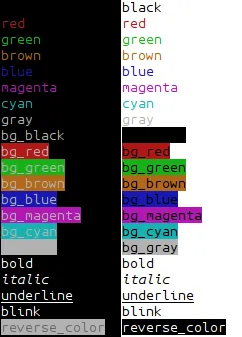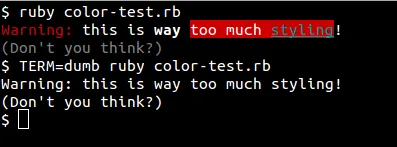使用Ruby,我该如何在终端输出时进行背景和前景文本着色?
我记得,在编写Pascal的时候,我们都会编写自己的textcolor(…)过程,以使我们的小型教育程序看起来更漂亮、更具表现力。
我应该如何用Ruby编写相当于它的东西?核心库中是否有内置支持可用?如果没有,什么是添加这个功能的惯用方法?
使用Ruby,我该如何在终端输出时进行背景和前景文本着色?
我记得,在编写Pascal的时候,我们都会编写自己的textcolor(…)过程,以使我们的小型教育程序看起来更漂亮、更具表现力。
我应该如何用Ruby编写相当于它的东西?核心库中是否有内置支持可用?如果没有,什么是添加这个功能的惯用方法?
Colorize是我最喜欢的gem!:-)
看看这个:
https://github.com/fazibear/colorize
安装:
gem install colorize
使用方法:
require 'colorize'
puts "I am now red".red
puts "I am now blue".blue
puts "Testing".yellow
win32console gem 并在 colorize 后面添加 require 'win32console',那么这段代码就可以在 Windows 命令提示符中正常运行。 - Benwin32console gem 了。https://github.com/luislavena/win32console/issues/17#issuecomment-20811539 - Dennis将以上答案结合起来,您可以实现类似于宝石colorize的东西,而无需其他依赖项。
class String
# colorization
def colorize(color_code)
"\e[#{color_code}m#{self}\e[0m"
end
def red
colorize(31)
end
def green
colorize(32)
end
def yellow
colorize(33)
end
def blue
colorize(34)
end
def pink
colorize(35)
end
def light_blue
colorize(36)
end
end
字符串类方法(仅适用于Unix):
class String
def black; "\e[30m#{self}\e[0m" end
def red; "\e[31m#{self}\e[0m" end
def green; "\e[32m#{self}\e[0m" end
def brown; "\e[33m#{self}\e[0m" end
def blue; "\e[34m#{self}\e[0m" end
def magenta; "\e[35m#{self}\e[0m" end
def cyan; "\e[36m#{self}\e[0m" end
def gray; "\e[37m#{self}\e[0m" end
def bg_black; "\e[40m#{self}\e[0m" end
def bg_red; "\e[41m#{self}\e[0m" end
def bg_green; "\e[42m#{self}\e[0m" end
def bg_brown; "\e[43m#{self}\e[0m" end
def bg_blue; "\e[44m#{self}\e[0m" end
def bg_magenta; "\e[45m#{self}\e[0m" end
def bg_cyan; "\e[46m#{self}\e[0m" end
def bg_gray; "\e[47m#{self}\e[0m" end
def bold; "\e[1m#{self}\e[22m" end
def italic; "\e[3m#{self}\e[23m" end
def underline; "\e[4m#{self}\e[24m" end
def blink; "\e[5m#{self}\e[25m" end
def reverse_color; "\e[7m#{self}\e[27m" end
end
并且用法:
puts "I'm back green".bg_green
puts "I'm red and back cyan".red.bg_cyan
puts "I'm bold and green and backround red".bold.green.bg_red
在我的控制台:

def no_colors
self.gsub /\e\[\d+m/, ""
end
去除格式化字符。
puts "\e[31m" # set format (red foreground)
puts "\e[0m" # clear format
puts "green-#{"red".red}-green".green # will be green-red-normal, because of \e[0
def bold; "\e[1m#{self}\e[22m" end - Kanat Bolazarcmd.exe 中,使用 puts "\e[0" 无法清除格式;必须使用 puts "\e[0m"。 - Nnnes我写了一个小方法来测试基础颜色模式,这个方法是基于Erik Skoglund和其他人的答案。
#outputs color table to console, regular and bold modes
def colortable
names = %w(black red green yellow blue pink cyan white default)
fgcodes = (30..39).to_a - [38]
s = ''
reg = "\e[%d;%dm%s\e[0m"
bold = "\e[1;%d;%dm%s\e[0m"
puts ' color table with these background codes:'
puts ' 40 41 42 43 44 45 46 47 49'
names.zip(fgcodes).each {|name,fg|
s = "#{fg}"
puts "%7s "%name + "#{reg} #{bold} "*9 % [fg,40,s,fg,40,s, fg,41,s,fg,41,s, fg,42,s,fg,42,s, fg,43,s,fg,43,s,
fg,44,s,fg,44,s, fg,45,s,fg,45,s, fg,46,s,fg,46,s, fg,47,s,fg,47,s, fg,49,s,fg,49,s ]
}
end
示例输出:
您可以使用ANSI转义序列在控制台中实现此操作。我知道这适用于Linux和Mac OS X,但我不确定Windows控制台(cmd)是否支持ANSI。
我在Java中实现了它,但思路是相同的。
// Foreground color
public static final String BLACK_TEXT() { return "\033[30m";}
public static final String RED_TEXT() { return "\033[31m";}
public static final String GREEN_TEXT() { return "\033[32m";}
public static final String BROWN_TEXT() { return "\033[33m";}
public static final String BLUE_TEXT() { return "\033[34m";}
public static final String MAGENTA_TEXT() { return "\033[35m";}
public static final String CYAN_TEXT() { return "\033[36m";}
public static final String GRAY_TEXT() { return "\033[37m";}
// Background color
public static final String BLACK_BACK() { return "\033[40m";}
public static final String RED_BACK() { return "\033[41m";}
public static final String GREEN_BACK() { return "\033[42m";}
public static final String BROWN_BACK() { return "\033[43m";}
public static final String BLUE_BACK() { return "\033[44m";}
public static final String MAGENTA_BACK() { return "\033[45m";}
public static final String CYAN_BACK() { return "\033[46m";}
public static final String WHITE_BACK() { return "\033[47m";}
// ANSI control characters
public static final String RESET_COLORS() { return "\033[0m";}
public static final String BOLD_ON() { return "\033[1m";}
public static final String BLINK_ON() { return "\033[5m";}
public static final String REVERSE_ON() { return "\033[7m";}
public static final String BOLD_OFF() { return "\033[22m";}
public static final String BLINK_OFF() { return "\033[25m";}
public static final String REVERSE_OFF() { return "\033[27m";}
TERM 设置为 dumb 以避免所有这些样式,例如将输出保存到文本文件中。而且,做正确的事情感觉很好。 :-)
您可以使用 ruby-terminfo gem。它需要一些C编译才能安装;我能在我的Ubuntu 14.10系统下安装它:
$ sudo apt-get install libncurses5-dev
$ gem install ruby-terminfo --user-install
然后你可以像这样查询数据库(请参阅terminfo手册,了解可用代码的列表):
require 'terminfo'
TermInfo.control("bold")
puts "Bold text"
TermInfo.control("sgr0")
puts "Back to normal."
puts "And now some " + TermInfo.control_string("setaf", 1) +
"red" + TermInfo.control_string("sgr0") + " text."
这是我编写的一个小封装类,使使用变得更加简单。
require 'terminfo'
class Style
def self.style()
@@singleton ||= Style.new
end
colors = %w{black red green yellow blue magenta cyan white}
colors.each_with_index do |color, index|
define_method(color) { get("setaf", index) }
define_method("bg_" + color) { get("setab", index) }
end
def bold() get("bold") end
def under() get("smul") end
def dim() get("dim") end
def clear() get("sgr0") end
def get(*args)
begin
TermInfo.control_string(*args)
rescue TermInfo::TermInfoError
""
end
end
end
使用方法:
c = Style.style
C = c.clear
puts "#{c.red}Warning:#{C} this is #{c.bold}way#{C} #{c.bg_red}too much #{c.cyan + c.under}styling#{C}!"
puts "#{c.dim}(Don't you think?)#{C}"

(编辑) 最后,如果您不想要求一个gem,您可以依赖于tput程序,如此描述 - Ruby示例:
puts "Hi! " + `tput setaf 1` + "This is red!" + `tput sgr0`
major, *major* +1表示对使用tput命令的大力赞扬。我无法形容tput命令为我节省了多少头发。请注意,这里的“头发”是比喻,意思是说tput帮助解决了很多问题,让工作更加轻松。 - Pierce我做了一个可以帮助的方法。虽然不是什么大不了的事情,但它很有效:
def colorize(text, color = "default", bgColor = "default")
colors = {"default" => "38","black" => "30","red" => "31","green" => "32","brown" => "33", "blue" => "34", "purple" => "35",
"cyan" => "36", "gray" => "37", "dark gray" => "1;30", "light red" => "1;31", "light green" => "1;32", "yellow" => "1;33",
"light blue" => "1;34", "light purple" => "1;35", "light cyan" => "1;36", "white" => "1;37"}
bgColors = {"default" => "0", "black" => "40", "red" => "41", "green" => "42", "brown" => "43", "blue" => "44",
"purple" => "45", "cyan" => "46", "gray" => "47", "dark gray" => "100", "light red" => "101", "light green" => "102",
"yellow" => "103", "light blue" => "104", "light purple" => "105", "light cyan" => "106", "white" => "107"}
color_code = colors[color]
bgColor_code = bgColors[bgColor]
return "\033[#{bgColor_code};#{color_code}m#{text}\033[0m"
end
这是如何使用它的方法:
puts "#{colorize("Hello World")}"
puts "#{colorize("Hello World", "yellow")}"
puts "#{colorize("Hello World", "white","light red")}"
可能的改进如下:
colors 和 bgColors 每次调用方法时都会被定义,且它们不会改变。bold、underline、dim 等。该方法对于 p 不起作用,因为 p 对其参数执行了 inspect。例如:
p "#{colorize("Hello World")}"
将显示"\e[0;38m你好世界\e[0m"
我使用了puts、print和Logger gem进行测试,它可以正常工作。
我改进了这个并创建了一个类,使得colors和bgColors成为类的常量,colorize成为一个类方法:
编辑:更好的代码风格,定义常量而不是类变量,使用符号而不是字符串,添加了更多选项,如加粗、斜体等。
class Colorizator
COLOURS = { default: '38', black: '30', red: '31', green: '32', brown: '33', blue: '34', purple: '35',
cyan: '36', gray: '37', dark_gray: '1;30', light_red: '1;31', light_green: '1;32', yellow: '1;33',
light_blue: '1;34', light_purple: '1;35', light_cyan: '1;36', white: '1;37' }.freeze
BG_COLOURS = { default: '0', black: '40', red: '41', green: '42', brown: '43', blue: '44',
purple: '45', cyan: '46', gray: '47', dark_gray: '100', light_red: '101', light_green: '102',
yellow: '103', light_blue: '104', light_purple: '105', light_cyan: '106', white: '107' }.freeze
FONT_OPTIONS = { bold: '1', dim: '2', italic: '3', underline: '4', reverse: '7', hidden: '8' }.freeze
def self.colorize(text, colour = :default, bg_colour = :default, **options)
colour_code = COLOURS[colour]
bg_colour_code = BG_COLOURS[bg_colour]
font_options = options.select { |k, v| v && FONT_OPTIONS.key?(k) }.keys
font_options = font_options.map { |e| FONT_OPTIONS[e] }.join(';').squeeze
return "\e[#{bg_colour_code};#{font_options};#{colour_code}m#{text}\e[0m".squeeze(';')
end
end
你可以通过以下方式使用它:
Colorizator.colorize "Hello World", :gray, :white
Colorizator.colorize "Hello World", :light_blue, bold: true
Colorizator.colorize "Hello World", :light_blue, :white, bold: true, underline: true
这是我为了使它能够正常工作而不需要任何宝石(gems)所做的:
def red(mytext) ; "\e[31m#{mytext}\e[0m" ; end
puts red("hello world")
然后只有引号中的文本被着色,你将返回到正常的程序。
e[32m一些文本。 - Oscar Godson"\e(...)" 而不是 "e\(...)"。 - arthropod我找到了几个:
http://github.com/ssoroka/ansi/tree/master
例子:
puts ANSI.color(:red) { "hello there" }
puts ANSI.color(:green) + "Everything is green now" + ANSI.no_color
http://flori.github.com/term-ansicolor/
示例:
print red, bold, "red bold", reset, "\n"
print red(bold("red bold")), "\n"
print red { bold { "red bold" } }, "\n"
http://github.com/sickill/rainbow
例子:
puts "this is red".foreground(:red) + " and " + "this on yellow bg".background(:yellow) + " and " + "even bright underlined!".underline.bright
class String; def red; colorize(self, "\033[31m"); end; end - Adriano P